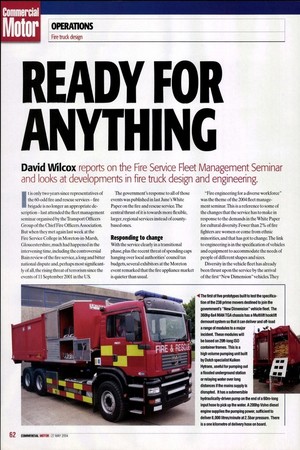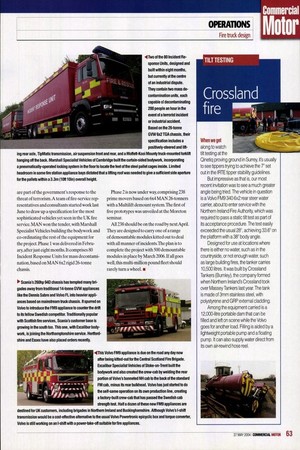READY FOR ANYTHING
Page 64

Page 65

If you've noticed an error in this article please click here to report it so we can fix it.
David Wilcox reports on the Fire Service Fleet Management Seminar
and looks at developments in fire truck design and engineering.
It is only two years since representatives of the 60-odd fire and rescue services — fire brigade is no longer an appropriate description— last attended the fleet management seminar organised by the Transport Officers Group of the Chief Fire Officers Association. But when they met again last week at the Fire Service College in Moreton-in-Marsh, Gloucestershire, much had happened in the intervening time, including the controversial Bain review of the fire service, a long and bitter national dispute and, perhaps most significantly of all, the rising threat of terrorism since the events of 11 September 2001 in the US.
The government's response to all of those events was published in last June's White Paper on the fire and rescue service.The central thrust of it is towards more flexible, larger, regional services instead of countybased ones. Responding to change
With the service clearly in a transitional phase, plus the recent threat of spending caps hanging over local authorities' council tax budgets, several exhibitors at the Moreton event remarked that the fire appliance market is quieter than usual.
"Fire engineering for a diverse workforce" was the theme of the 2004 fleet management seminar.This is a reference to some of the changes that the service has to make in response to the demands in the White Paper for cultural diversity Fewer than 2% of fire fighters are women or come from ethnic minorities, and that has got to change. The link to engineering is in the specification of vehicles and equipment to accommodate the needs of people of different shapes and sizes. Diversity in the vehicle fleet has already been thrust upon the service by the arrival of the first "New Dimension" vehicles.They
are part of the government's response to the threat of terrorism.A team of fire-service representatives and consultants started work last June to draw up a specification for the most sophisticated vehicles yet seen in the UK fire service. MAN won the tender, with Marshall Specialist Vehicles building the bodywork and co-ordinating the rest of the equipment for the project. Phase 1 was delivered in February, after just eight months. It comprises 80 Incident Response Units for mass decontamination, based on MAN 6x2 rigid 26-tonne chassis.
Phase 2 is now underway, comprising 238 prime movers based on 6x4 MAN 26-tonners with a Multilift demount system. The first of five prototypes was unveiled at the Moreton seminar.
All 238 should be on the road by next April. They are designed to carry one of a range of demountable modules kitted out to deal with all manner of incidents, The plan is to complete the project with 500 demountable modules in place by March 2006. If all goes well, this multi-million pound fleet should rarely turn a wheel.
When we get along to watch tilt testing at the Qinetiq proving ground in Surrey, it's usually to see tippers trying to achieve the 7° set out in the IRTE tipper stability guidelines.
But impressive as that is, our most recent invitation was to see a much greater angle being tried. The vehicle in question is a Volvo FM9 340 6x2 rear steer water carrier, about to enter service with the Northern Ireland Fire Authority, which was required to pass a static tilt test as part of its acceptance procedure. The test easily exceeded the usual 28°, achieving 33.6° on the platform with a 38° body angle.
Designed for use at locations where there is either no water, such as in the countryside, or not enough water, such as large building fires, the tanker carries 10,500 litres. It was built by Crossland Tankers (Burnley), the company formed when Northern Irelands Crossland took over Massey Tankers last year. The tank is made of 3mm stainless steel, with polystyrene and GRP external cladding.
Among the equipment carried is a 12,000-litre portable dam that can be filled and left on scene while the Volvo goes for another load. Filling is aided by a lightweight portable pump and a floating pump. It can also supply water direct from its own air-rewind hose reel.






























































































































































































